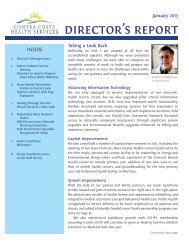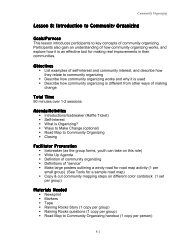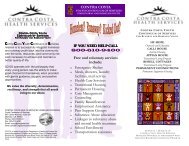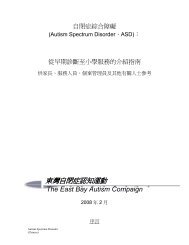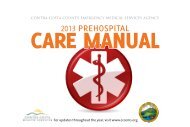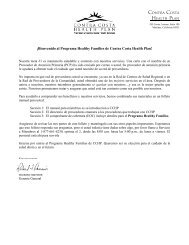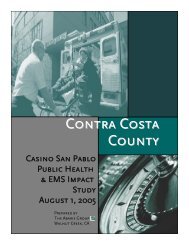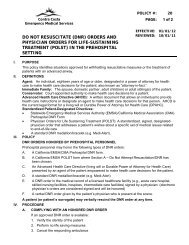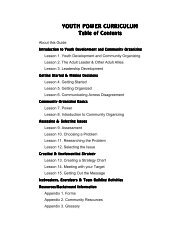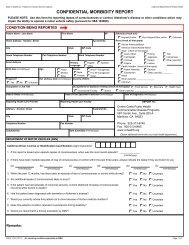EMS Policy Manual - Contra Costa Health Services
EMS Policy Manual - Contra Costa Health Services
EMS Policy Manual - Contra Costa Health Services
Create successful ePaper yourself
Turn your PDF publications into a flip-book with our unique Google optimized e-Paper software.
<strong>Contra</strong> <strong>Costa</strong><br />
Emergency Medical <strong>Services</strong><br />
<strong>EMS</strong> RESPONSE TO HAZARDOUS MATERIALS<br />
INCIDENTS<br />
POLICY #: 36<br />
PAGE: 1 of 2<br />
EFFECTIVE: 7/5/2011<br />
REVIEWED: 7/5/2011<br />
I. PURPOSE<br />
To prevent exposure or contamination of prehospital personnel, other first responders,<br />
emergency department personnel and the receiving facility to hazardous material incidents.<br />
II. AUTHORITY<br />
California <strong>Health</strong> & Safety Code, Section 1798.6 (b) (c) Hazardous Materials Incidents.<br />
California <strong>Health</strong> & Safety Code; Ch 4; Division 2.5; Title 22.<br />
The responsibility for hazardous materials containment, identification, and decontamination, and<br />
victim evacuation at the scene of incident shall rest with the designated public safety agencies as<br />
defined in the <strong>Contra</strong> <strong>Costa</strong> County Hazardous Materials Area Plan (HMAP).<br />
III. DEFINITIONS<br />
Contamination: When a hazardous material is physically present on a person’s skin, clothing or<br />
hair (external) or has been inhaled or ingested (internal).<br />
Decontamination: The act of removing or neutralizing any contaminant from people or equipment.<br />
DOT Identification Number: Signage system developed by the U.S. Department of Transportation<br />
which utilizes a series of four (4) digits to identify and provide basic information on specific<br />
hazardous materials.<br />
Exposure: Contact by any means with a hazardous material.<br />
Hazardous Materials: A material that, because of its quantity, concentration, or physical or<br />
chemical characteristics, poses a significant present or potential hazard to human health and<br />
safety or to the environment if released into the workplace or the environment.<br />
Hazardous Materials Incidents: A release or threatened release of hazardous materials.<br />
Hazardous Material Incident Notification: The process of informing the appropriate regulatory<br />
authorities and agencies of a hazardous materials incident.<br />
Hazardous Materials Area Plan (HMAP): The HMAP describes the overall hazardous materials<br />
emergency response within <strong>Contra</strong> <strong>Costa</strong> County and establishes lines of authority for hazardous<br />
materials incidents. Available at: http://www.cchealth.org/groups/hazmat/pdf/2009_area_plan.pdf<br />
Exclusion (Hot) Zone: Area that encompasses all known or suspected hazardous materials.<br />
Material Safety Data Sheet (MSDS): MSDS is a form describing the properties of a particular<br />
substance. It is intended to provide workers and emergency personnel with procedures for handling<br />
or working with that substance in a safe manner.<br />
Prehospital Provider: <strong>EMS</strong> and Fire First Responders and/or Transport Providers.<br />
Support (Warm) Zone: Area between the Hot Zone and the location where equipment and rescue<br />
personnel are staged to receive and treat decontaminated patients.<br />
IV. PREHOSPITAL PROVIDER AND PROVIDER AGENCY RESPONSIBILITIES<br />
Prehospital Providers and their Provider Agencies shall comply with state and federal standards<br />
involving hazardous materials.<br />
Prehospital Providers shall participate in hazardous materials awareness level training programs.<br />
All prehospital providers shall be trained in when and how to perform a Hazardous Material Incident<br />
Notification.



